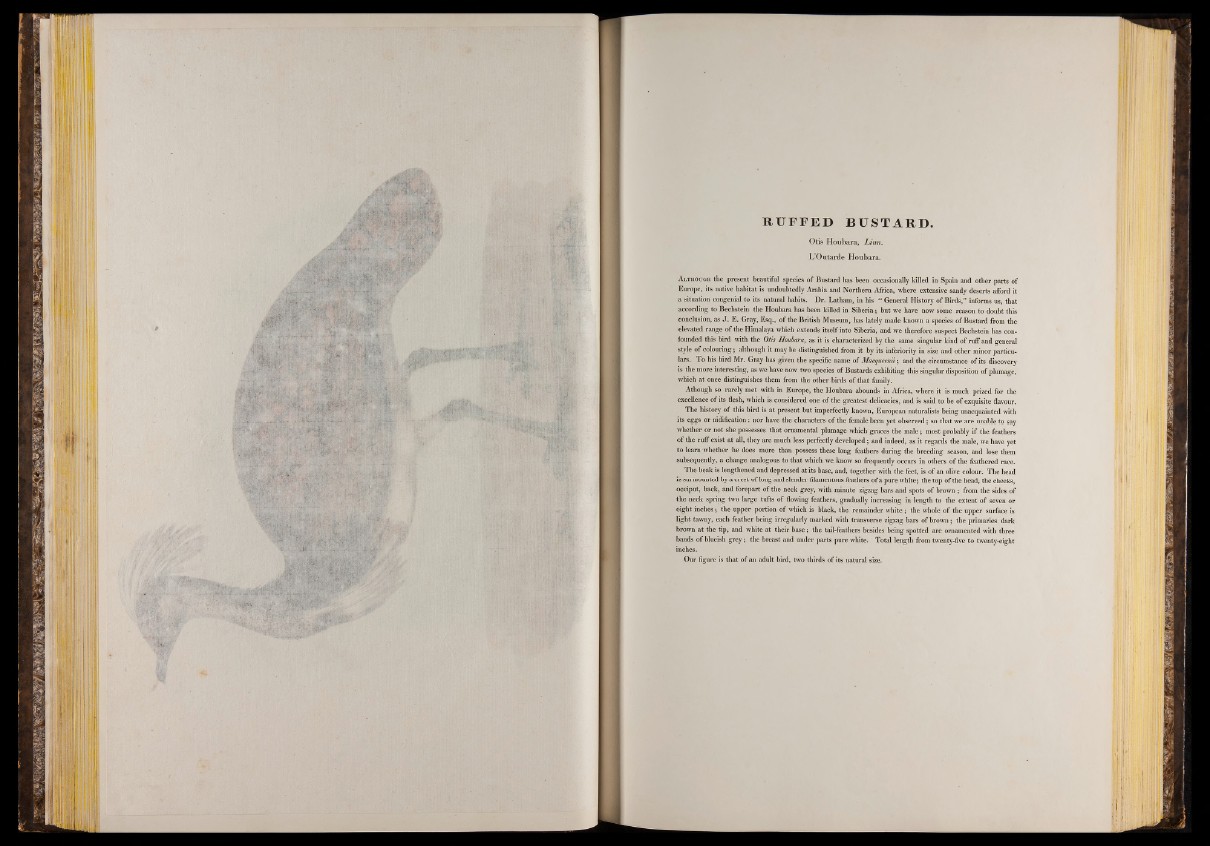
H U ■
Ü
f iB É lC S
-
i Í íÍ É É
RUF F ED BUSTARD.
Otis H ou b a ra , Lin n .
L ’O u ta rd e Hou b ara .
A l t h o u g h the present beautiful species o f Bustard has been occasionally killed in Spain and other parts of
Europe, its native habitat is undoubtedly Arabia and Northern Africa, where extensive sandy deserts afford it
a situation congenial to its natural habits. Dr. Latham, in his “ General History o f Birds,” informs us, that
according to Bechstein the Houbara has been killed in Siberia; but we have now some reason to doubt this
conclusion, as J . E. Gray, Esq., o f the British Museum, has lately made known a species o f Bustard from the
elevated range o f the Himalaya which extends itself into Siberia, and we therefore suspect Bechstein has confounded
this bird with the Otis Houbara, as it is characterized by the same singular kind o f ruff and general
style o f colouring; although it may be distinguished from it by its inferiority in size and other minor particulars.
To his bird Mr. Gray has given the specific name o f Macqueenii; and the circumstance o f its discovery
is the more interesting, as we have now two species o f Bustards exhibiting this singular disposition o f plumage,
which at once distinguishes them from the other birds o f that family.
Athough so rarely met with in Europe, the Houbara abounds in Africa, where it is much prized for the
excellence o f its flesh, which is considered one o f the greatest delicacies, and is said to he o f exquisite flavour.
The history o f this bird is at present but imperfectly known, European naturalists being unacquainted with
its eggs or nidification: nor have the characters o f the female been yet observed; so that we are unable to say
whether or not she possesses that ornamental plumage which graces the male; most probably i f the feathers
o f the ruff exist at all, they are much less perfectly developed; and indeed, as it regards the male, we have yet
to learn whether he does more than possess these long feathers during the breeding season, and lose them
subsequently, a change analogous to that which we know so frequently occurs in others o f the feathered race.
The beak is lengthened and depressed at its base, and, together with the feet, is o f an olive colour. The head
is surmounted by a crest o f long and slender filamentous feathers o f a pure white; the top o f the head, the cheeks,
occiput, back, and forepart o f the neck grey, with minute zigzag bars and spots o f brown ; from the sides of
the neck spring two large tufts o f flowing feathers, gradually increasing in length to the extent o f seven or
eight inches; the upper portion o f which is black, the remainder white; the whole o f the upper surface is
light tawny, each feather being irregularly marked with transverse zigzag bars o f brown; the primaries dark
brown at the tip, and white at their base; the tail-feathers besides being spotted are ornamented with three
bands o f blueish g re y ; the breast and under parts pure white. Total length from twenty-five to twenty-eight
inches.
Our figure is that o f an adult bird, two thirds o f its natural size.